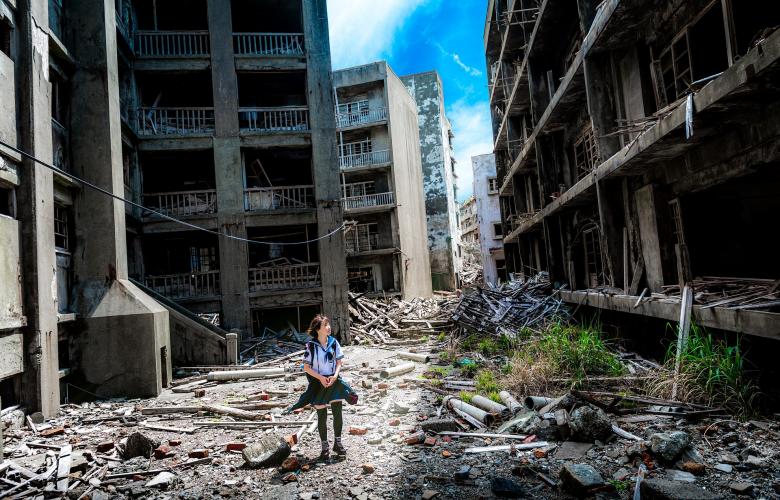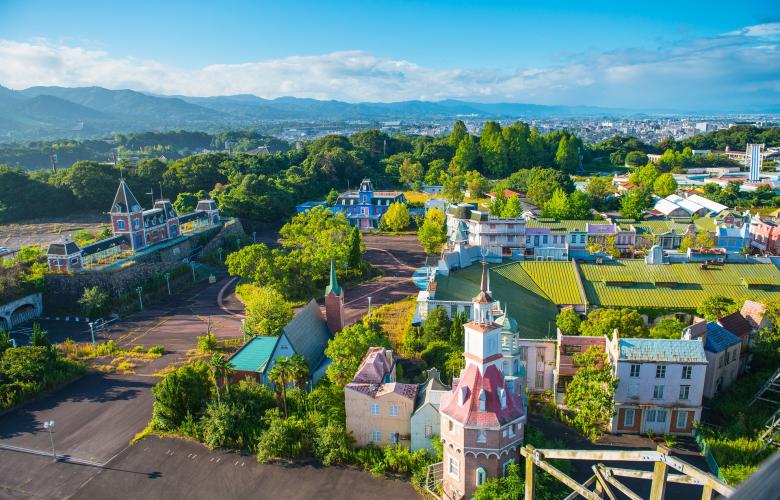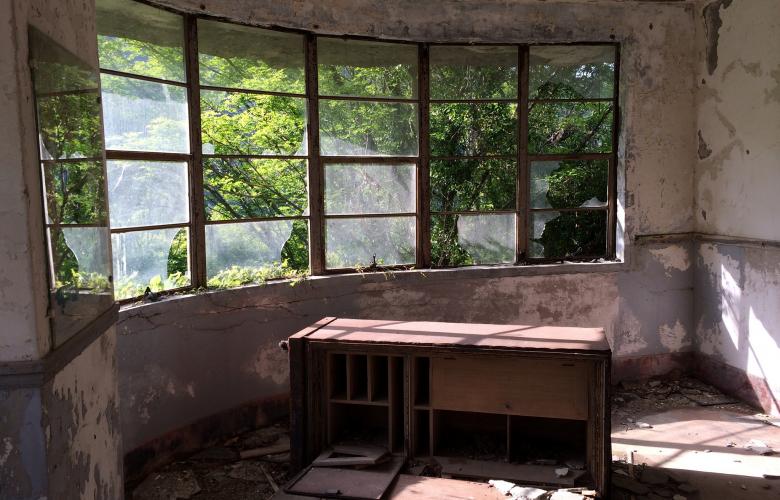Stepping from a window ledge into the dusty hall of a long-silent school is a moment of delicate trespass — an unshakeable sense of the illicit coats the moment in an addictive shimmer. This is the world of haikyo: the exploration of abandoned structures, decaying, dangerous and, at times, hauntingly beautiful. A growing cult-hobby among a tight-knit group of enthusiasts, this alternative form of adventuring offers plenty of insight into the past — and present — of Japan.
Meaning "ruins", haikyo is known abroad as urbex, short for urban exploration. And while the charm of exploring a mould-ridden building may be lost on some, the attractions for explorers vary. From keen photographers to historians who prefer a more practical approach, the sense of exploration and thrill of entering a land unknown is an undeniable draw. Although some stumble upon the hobby while hiking, many seek out destinations and travel extensively to reach them. This isn't always necessary, however, as some forgotten buildings remain in cities, including Tokyo.

Developing into a recognized trend in the late 80s and early 90s, haikyo took advantage of the growing number of hotels, resorts and other buildings which were abandoned following the crash of the bubble market in the early 90s. During what was known as the Lost Decade, a number of buildings were left half-built (like the Yamanakako Resort Hotel in Yamanashi) or slowly became untenable in the depression-influenced market (like the Maya Hotel in Hyogo, which had welcomed guests from 1929 until its closure in 1994).
Serving as a blunt visual reminder of the failed economy, these once opulent locations were the perfect symbol of the brutal fall from grace Japan suffered. True to the age-old adage of pride preceding a fall, it was the most extravagant examples that were the first to be abandoned. It appears only fitting, therefore, that their remains were left to be explored, much as the remnants of Japan's economy were later investigated.
The crash was not the only contributor to the wealth of forgotten properties, however. Japan's declining population is slowly but surely claiming buildings and swallowing communities, especially in more rural areas. Empty schools are some of the most blatant repercussions of an aging population and are easily found across the country. Almost entirely built in the same familiar design, they are constructed to serve as evacuation points and thus will last for decades without decay.
Owned by the government, they are rarely demolished and many are left perfectly intact, with chalk resting beside boards and umbrellas remaining in stands. In areas with a high rate of school closure, like the mountainous area of Miyoshi in Tokushima, the council are taking a different step. To support the local tourist industry, they offered the schools to designers and small businesses to create hostels, one of which is the Haretoke Design Hostel. Created by a Tokyo designer and her chef sister, it is now an unusual cafe and hostel, serving the needs of both the community and visitors (albeit not haikyo enthusiasts).
In these shrinking communities, services are often centralised over time, and clinics, hospitals and other everyday locations are eventually closed, but rarely removed. In some cases, entire villages are lost in one fell swoop — often triggered by the closure of the mine or factory which launched the community in the first place. Spots like Sanno, a logging village in Yamanashi and Shiraiwa in Saitama, are literal ghost towns — abandoned along with a surprising amount of personal belongings. There are, unfortunately, villages approaching a similar status today, such as Yubari which is down to less than 10% of its peak population.

The most famous example of these abandoned mining towns is known by the nickname Battleship Island (Gunkanjima in Japanese), although its real name is Hashima. Surrounded by seawalls and containing a whole concrete city, it has served as the setting for a James Bond film and is a designated UNESCO World Heritage Site. Once claiming the highest population density on earth, it was abruptly emptied when the coal mine closed in 1974. Now, it serves as a popular tourist destination in Nagasaki, with public tours allowing access to a small section, and special approval required to visit the rest.
This public form of haikyo is unusual, although it is not unique in Japan, with some examples hiding in plain sight. A more instantly recognisable testament to the horrors of the past than the Hiroshima A-Bomb Dome is hard to find, and its existence reflects a version of haikyo. Although it cannot be explored and lacks the thrill of breaking the albeit minor laws of traditional examples, the horror of what it represents transports people to a pivotal moment in societal history, both that of Japan and the collective world. This power taps into one of the most addictive aspects of haikyo: the desire to stand in the past, surrounded by its artifacts and the structures that have survived it.
The need for a link to the past is stronger in Japan more than most countries, and highlights why the pursuit of locations has a stronger pull than elsewhere. Thanks to a history of natural disasters and the practical challenges of ever-evolving construction laws, a culture of transience has surrounded buildings. Everything from the modest family home to the revered shrine is systematically erased and replaced every few decades, giving the survivors a rare charm that's hard to resist.
Run-of-the-mill family homes and businesses make up a good number of haikyo properties, with some becoming legendary. The Royal House in Kanagawa is as close to a celebrity as it gets in the community thanks to its rich history and fascinating past. A wooden house filled with countless intriguing personal items including photos with royalty, hotel-packaged boxes and signs of times gone by, it has a definite Marie-Celeste vibe. The opportunity to explore a house with history is such a rare thing in a country which values privacy and demolishes homes, it is no wonder properties like this are prized and fiercely protected.
These easily accessed but rarely defaced examples stand as testament to the low levels of crime in Japan and the overall respect for the property of others. At a small village school in Mie, an otherwise untouched school, has a simple apology on a blackboard, explaining that the author took a few items in desperate need, and was profusely sorry.
That isn't to say that graffiti and vandalism are non-existent, but it is notable that the more impersonal the building, the higher the level of damage. When it comes to graffiti, it could be said that larger walls simply offer a better canvas than a wooden home, but the lack of arson and stealing suggests there is more to it than that. An inherent respect for personal spaces is maintained, making the experience of exploring the spaces all the more moving as they envelop both the stories of the past and the respect of the present.
The fear of damage is one of the reasons behind the secrecy which has enshrouded many locations, with the enthusiasts rarely making locations public. While the wish to protect some places is understandable, and with some dangerous to visit (not to mention largely illegal) there is a certain level of superiority that comes with knowing the best locations. The thrill of exploring an abandoned space is lost, after all, when you run into others along the way.

With the arrival of the internet and the publication of Nippon no Haikyo in 2007, however, locations are slowly becoming more public and places are visited more often. While this means more people have the opportunity to experience haikyo and its delights, the increased footfall at larger properties has lead to more demolitions and more stringent alarm systems. Locations like Nara Dreamland, a themepark in the Kansai region drew so much attention that it was eventually knocked down. While the expenses of demolition and the tax benefits of keeping property on the land often result in buildings standing for years, the risk of costs incurred by injured explorers is enough to force an owner's hand.
This respect, or the lack of, has placed the more controversial aspects of the hobby under the spotlight in Japan in recent times. In 2016, Polish photographer Arkadiusz Podniesinski entered and photographed the exclusions zone surrounding the Fukushima Nuclear Plant extensively. Damaged in the 2011 Tohoku earthquake, the nuclear plant contaminated the surrounding area and residents were evacuated for the foreseeable future.
Although he was granted permits to enter the area, the photographs drew criticism for exploiting the remains of a community and using personal loss to achieve viral social-media attention. While there was certainly a fascination with the images, which were hauntingly reminiscent of a post-apocalyptic film, the feeling of intrusion was unbearable for many. This vital line of where respect and intrusion lie is hard to place in a hobby which relies on — and even thrives on — the abandonment of places once needed by people, coating them all in a melancholy hue.
While some seem victimless, like the abandoned hotels of the bubble market crash, some have a darker past. The Seika Dormitory is a Tokyo-based structure which is an accessible, sturdy and intriguing property, with plenty of personal items. It is also the site of a tragic fire, however, which killed two residents and injured others, leading to its abandonment. While not all are so clearly linked to tradgedy, popular locations such as hospitals offer a grey area in moral exploration.
Now used as settings for music videos and extensively photographed for coffee-table compendiums, haikyo is more visible and likely to grow in popularity. While many will never venture as far as climbing fences and slipping under gates, a small number will be. Without increased immigration, Japan faces an ever-falling population, and the number of properties added to the roster of haikyo destinations is only set to increase.
By Lily Crossley-Baxter
Similar to this:
Out with the old, in with the new: Why older buildings are unpopular in Japan
Disaster and design: Temporary housing in Japan
Danchi Dreams: A photographic exploration of a housing vision










